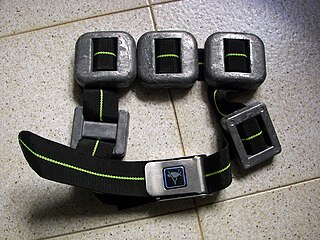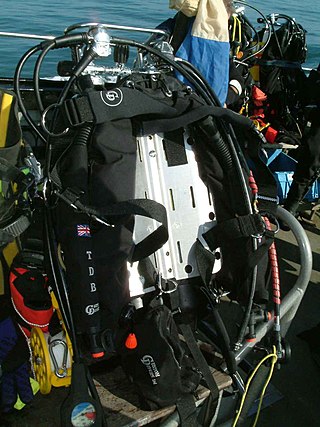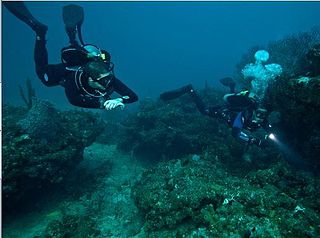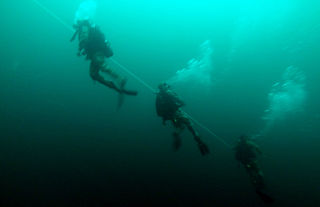
A scuba set, originally just scuba, is any breathing apparatus that is entirely carried by an underwater diver and provides the diver with breathing gas at the ambient pressure. Scuba is an anacronym for self-contained underwater breathing apparatus. Although strictly speaking the scuba set is only the diving equipment that is required for providing breathing gas to the diver, general usage includes the harness or rigging by which it is carried and those accessories which are integral parts of the harness and breathing apparatus assembly, such as a jacket or wing style buoyancy compensator and instruments mounted in a combined housing with the pressure gauge. In the looser sense, scuba set has been used to refer to all the diving equipment used by the scuba diver, though this would more commonly and accurately be termed scuba equipment or scuba gear. Scuba is overwhelmingly the most common underwater breathing system used by recreational divers and is also used in professional diving when it provides advantages, usually of mobility and range, over surface-supplied diving systems and is allowed by the relevant legislation and code of practice.

A dry suit or drysuit provides the wearer with environmental protection by way of thermal insulation and exclusion of water, and is worn by divers, boaters, water sports enthusiasts, and others who work or play in or near cold or contaminated water. A dry suit normally protects the whole body except the head, hands, and possibly the feet. In hazmat configurations, however, all of these are covered as well.

A buoyancy compensator (BC), also called a buoyancy control device (BCD), stabilizer, stabilisor, stab jacket, wing or adjustable buoyancy life jacket (ABLJ), depending on design, is a type of diving equipment which is worn by divers to establish neutral buoyancy underwater and positive buoyancy at the surface, when needed.

A diving weighting system is ballast weight added to a diver or diving equipment to counteract excess buoyancy. They may be used by divers or on equipment such as diving bells, submersibles or camera housings.

The buddy check is a procedure carried out by scuba divers using the buddy system where each diver checks that the other's diving equipment is configured and functioning correctly just before the start of the dive. A study of pre-dive equipment checks done by individual divers showed that divers often fail to recognize common equipment faults. By checking each other's equipment as well as their own, it is thought to be more likely that these faults will be identified prior to the start of the dive.

A backplate and wing is a type of scuba harness with an attached buoyancy compensation device (BCD) which establishes neutral buoyancy underwater and positive buoyancy on the surface. Unlike most other BCDs, the backplate and wing is a modular system, in that it consists of separable components. The core components of this system are:

Scuba diving is a mode of underwater diving whereby divers use breathing equipment that is completely independent of a surface breathing gas supply, and therefore has a limited but variable endurance. The name scuba is an anacronym for "Self-Contained Underwater Breathing Apparatus" and was coined by Christian J. Lambertsen in a patent submitted in 1952. Scuba divers carry their own source of breathing gas, usually compressed air, affording them greater independence and movement than surface-supplied divers, and more time underwater than free divers. Although the use of compressed air is common, a gas blend with a higher oxygen content, known as enriched air or nitrox, has become popular due to the reduced nitrogen intake during long or repetitive dives. Also, breathing gas diluted with helium may be used to reduce the effects of nitrogen narcosis during deeper dives.

Diver rescue, usually following an accident, is the process of avoiding or limiting further exposure to diving hazards and bringing a diver to a place of safety. A safe place generally means a place where the diver cannot drown, such as a boat or dry land, where first aid can be administered and from which professional medical treatment can be sought. In the context of surface supplied diving, the place of safety for a diver with a decompression obligation is often the diving bell.

Finning techniques are the skills and methods used by swimmers and underwater divers to propel themselves through the water and to maneuver when wearing swimfins. There are several styles used for propulsion, some of which are more suited to particular swimfin configurations. There are also techniques for positional maneuvering, such as rotation on the spot, which may not involve significant locational change. Use of the most appropriate finning style for the circumstances can increase propulsive efficiency, reduce fatigue, improve precision of maneuvering and control of the diver's position in the water, and thereby increase the task effectiveness of the diver and reduce the impact on the environment. Propulsion through water requires much more work than through air due to higher density and viscosity. Diving equipment which is bulky usually increases drag, and reduction of drag can significantly reduce the effort of finning. This can be done to some extent by streamlining diving equipment, and by swimming along the axis of least drag, which requires correct diver trim. Efficient production of thrust also reduces the effort required, but there are also situations where efficiency must be traded off against practical necessity related to the environment or task in hand, such as the ability to maneuver effectively and resistance to damage of the equipment.

Sidemount is a scuba diving equipment configuration which has scuba sets mounted alongside the diver, below the shoulders and along the hips, instead of on the back of the diver. It originated as a configuration for advanced cave diving, as it facilitates penetration of tight sections of cave, allows easy access to cylinder valves, provides easy and reliable gas redundancy, and tanks can be easily removed when necessary. These benefits for operating in confined spaces were also recognized by divers who conducted technical wreck diving penetrations.

Diving equipment is equipment used by underwater divers to make diving activities possible, easier, safer and/or more comfortable. This may be equipment primarily intended for this purpose, or equipment intended for other purposes which is found to be suitable for diving use.

Scuba gas planning is the aspect of dive planning and of gas management which deals with the calculation or estimation of the amounts and mixtures of gases to be used for a planned dive. It may assume that the dive profile, including decompression, is known, but the process may be iterative, involving changes to the dive profile as a consequence of the gas requirement calculation, or changes to the gas mixtures chosen. Use of calculated reserves based on planned dive profile and estimated gas consumption rates rather than an arbitrary pressure is sometimes referred to as rock bottom gas management. The purpose of gas planning is to ensure that for all reasonably foreseeable contingencies, the divers of a team have sufficient breathing gas to safely return to a place where more breathing gas is available. In almost all cases this will be the surface.

An emergency ascent is an ascent to the surface by a diver in an emergency. More specifically, it refers to any of several procedures for reaching the surface in the event of an out-of-air emergency, generally while scuba diving.

Scuba skills are skills required to dive safely using SCUBA, an acronym for self-contained underwater breathing apparatus, known as a scuba set. Most of these skills are relevant to both open-circuit scuba and rebreather scuba, and also to surface-supplied diving. Certain scuba skills, which are critical to divers' safety, may require more practice than standard recreational training provides.
Investigation of diving accidents includes investigations into the causes of reportable incidents in professional diving and recreational diving accidents, usually when there is a fatality or litigation for gross negligence.
Diving procedures are standardised methods of doing things that are commonly useful while diving that are known to work effectively and acceptably safely. Due to the inherent risks of the environment and the necessity to operate the equipment correctly, both under normal conditions and during incidents where failure to respond appropriately and quickly can have fatal consequences, a set of standard procedures are used in preparation of the equipment, preparation to dive, during the dive if all goes according to plan, after the dive, and in the event of a reasonably foreseeable contingency. Standard procedures are not necessarily the only courses of action that produce a satisfactory outcome, but they are generally those procedures that experiment and experience show to work well and reliably in response to given circumstances. All formal diver training is based on the learning of standard skills and procedures, and in many cases the over-learning of the skills until the procedures can be performed without hesitation even when distracting circumstances exist. Where reasonably practicable, checklists may be used to ensure that preparatory and maintenance procedures are carried out in the correct sequence and that no steps are inadvertently omitted.

Human factors in diving equipment design are the influences of the interactions between the user and equipment in the design of diving equipment and diving support equipment. The underwater diver relies on various items of diving and support equipment to stay alive, healthy and reasonably comfortable and to perform planned tasks during a dive.






















